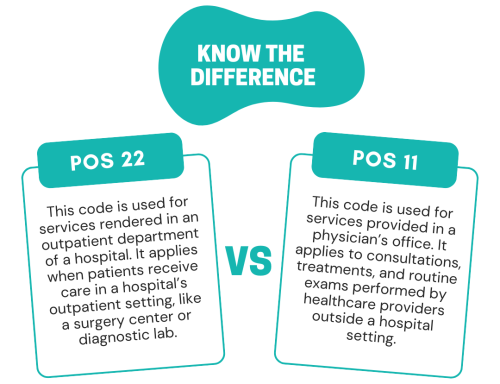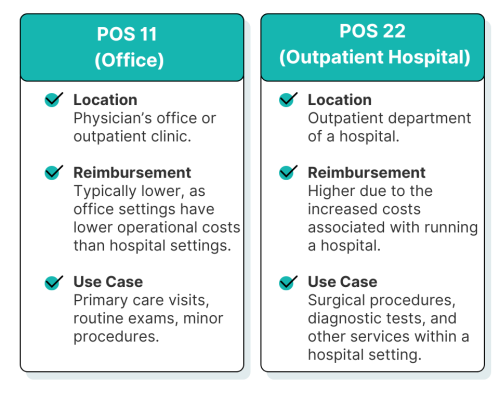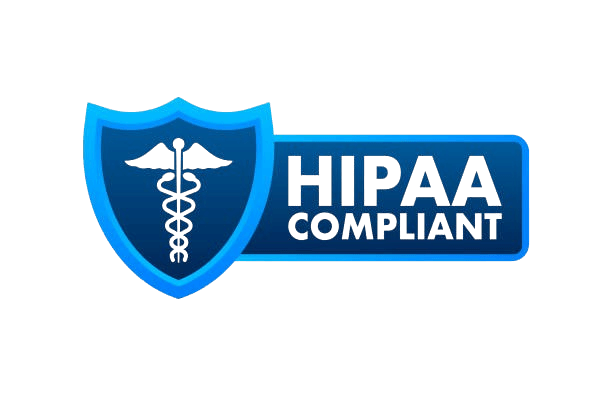Decoding the Essentials of POS 22 and POS 11 in Medical Billing

BLOG OUTLINE
- Introduction to Place of Service (POS) Codes
- Common Examples of Facility POS Codes
- Common Examples of Non-Facility POS Codes
- Understanding POS 22 and POS 11 in Medical Billing
- Importance of POS 22 POS 11 in Healthcare Facilities
- Common Misconceptions About POS 22 and POS 11
- Billing Guidelines for using POS 22 and POS 11
- Benefits of Accurate POS 22 Reporting and POS 11
- Compliance Requirements related to POS 22 and POS 11
- Training Staff on Proper POS 22 and POS 11 Coding
- Impact of POS 22 and POS 11 on Reimbursement Rates
- Comparative Analysis: POS Code 22 vs POS 11 in Medical Billing
- Conclusion and Key Takeaways
Introduction to Place of Service (POS) Codes
Understanding the essentials of POS 22 and POS 11 in medical billing is crucial for precised medical coding and accurate reimbursement. Place of Service (POS) codes are standardized codes used to identify where a medical service or procedure was provided by healthcare provider. In medical billing, these codes help insurance companies to understand the location where services were rendered, whether it’s a hospital, physician’s office, or other healthcare facilities so to ensure that healthcare providers are paid accurately.
Each POS code corresponds to a specific location, such as a doctor’s office, outpatient hospital, or a patient’s home. Application of right POS code is essential for compliance with payer guidelines to avoid claim denials. In this blog, we will explore the essentials of POS 22 and POS 11 in medical billing, highlighting their differences and explaining why it matters.
For Insurance Credentialing, Medical Billing Services and other services
Some Common Examples of Facility POS Codes
Facility POS codes are used for services rendered in healthcare environments like hospitals, emergency rooms, or outpatient facilities. These codes help distinguish between different types of care settings.
For example, if a patient has surgery in a hospital outpatient setting, POS 22 is the appropriate code. This distinction ensures that the service is billed according to the correct facility, leading to accurate reimbursement.
Non-Facility POS Codes
Non-facility POS codes, on the other hand, apply to healthcare services delivered outside traditional hospital settings. These codes are used for services rendered in physician offices, clinics, or at home. The essentials of POS 22 and POS 11 in medical billing are especially important when distinguishing between these two types of settings.
Some common non-facility POS codes include:
Using the correct non-facility code ensure alignment of reimbursement with the specific care facility, which can differ significantly from hospital-based services.
Understanding POS 22 and POS 11 in Medical Billing
When it comes to the essentials of POS 22 and POS 11 in medical billing, understanding the differences between these two codes is critical.

POS Example Scenario
Imagine a patient visits a hospital outpatient clinic for a routine diagnostic test. The healthcare provider should use POS 22 to reflect that the service was provided in the hospital’s outpatient department.
In contrast, if the patient visits a physician’s office for a check-up, POS 11 would be the correct code. The key difference lies in the facility—hospital outpatient versus private office.
POS 11 vs POS 22 Codes in Medical Billing
Their Importance and Key Differences Explained
Understanding the differences between POS 11 and POS 22 is crucial for both accurate billing and maximizing reimbursement. Let’s break down the key distinctions:

Why Does This Matter?
For accurate billing, you need to use the correct POS code. Incorrect use of POS 11 and POS 22 can result in denied claims, delayed payments, and potential underpayment.
Importance of POS 22 and POS 11 in Healthcare Facilities
Correctly coding POS 22 and POS 11 is critical for healthcare facilities to ensure proper reimbursement. When claims are submitted with incorrect codes, it can lead to significant financial implications, such as delayed payments or claim denials.
- POS 22 ensures that hospital outpatient services are recognized, which is important for facilities to receive appropriate reimbursement for their higher overhead costs.
- POS 11, used for physician office visits, helps reflect the more cost-effective setting of care and ensures physicians are paid accurately for their services.
Common Misconceptions About POS 22 and POS 11 in medical billing
There are a few common misconceptions regarding POS 22 and POS 11 in medical billing that can lead to errors in coding:
Some providers may confuse outpatient hospital services (POS 22) with physician office visits (POS 11), leading to underpayment or denial.
While POS 22 usually offers higher reimbursement rates due to hospital overhead costs, this isn't always the case. Some insurers may reimburse differently based on the type of service provided.
Not every office visit should be coded as POS 11. For example, telehealth visits might need a different code. Ensuring your billing matches the exact nature of the service is key.
Billing Guidelines for Using POS 22 and POS 11 in medical billing
Benefits of Accurate Reporting POS 22 and pos 11 in medical billing
Correct POS 22 and POS 11 reporting offers several advantages which includes reduced clam denials as correct application of POS codes minimizes the risk of claims being denied due to coding errors. One more benefit of accurate reporting is maximized reimbursement. By using the correct POS codes, healthcare providers are most likely to be reimbursed according to the correct fee schedule for each setting. Moreover, accurate application of POS in medical coding ensures compliance with payer guidelines and reduces the risk of compliance audits.
Training Staff on Proper POS 22 and POS 11 Coding
Proper training is essential for reducing errors and ensuring that the essentials of POS 22 and POS 11 in medical billing are correctly understood. Key training points should include:
- Understanding the differences between POS 11 and POS 22.
- Knowing when and why to use each code
- Reviewing payer-specific guidelines to avoid potential mistakes.
Impact of POS 22 and POS 11 on Reimbursement Rates
Comparative Analysis: POS 22 and POS 11 in Medical Billing
A side-by-side look at Place of Service POS 11 (Office) and POS 22 (On-campus Outpatient Hospital)
| Feature | POS 11 — Office | POS 22 — On-Campus Outpatient Hospital |
|---|---|---|
| Definition | Physician’s office or private practice where health professionals provide services in a non-hospital setting. | Hospital outpatient facility located on the hospital campus where patients receive diagnostic or treatment services. |
| Typical Setting | Private practice, independent clinic, or physician office not physically on a hospital campus. | Hospital outpatient department physically located on the same campus as the hospital. |
| Reimbursement | Typically higher professional reimbursement (no facility fee), though this varies by payer. | Professional fees may be lower; hospital bills a separate facility fee which increases total reimbursement to the system. |
| Billing Entity | Physician or clinic usually bills the professional component (CMS-1500). | Split billing: provider bills professional fee (CMS-1500) and hospital bills facility charges (UB-04). |
| Common Services | Office visits, routine follow-ups, minor in-office procedures. | Outpatient surgery, advanced diagnostics, specialty clinics, complex procedures requiring hospital resources. |
| Prior Authorization | Depends on payer and service — common for certain procedures/therapies. | Often required for higher-cost outpatient services; verify payer policy. |
| Claim Forms | CMS-1500 for professional services. | CMS-1500 for professional services; UB-04 for facility charges. |
| Impact on Patient Cost | Usually lower out-of-pocket costs (no facility fee) — depends on plan benefits. | Often higher out-of-pocket due to facility fee and separate cost-sharing for hospital services. |
| Example POS Code | 11 | 22 |

